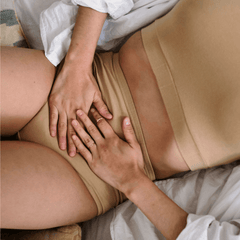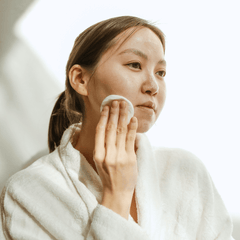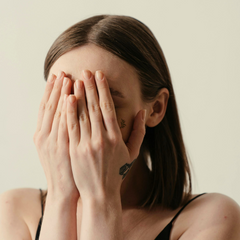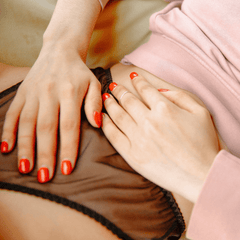How To Identify and Treat Your Hormonal Acne Type

Hormonal acne is one of the most common forms of acne, but it’s often misunderstood. While many people assume it’s simply caused by high testosterone, the reality is more complex. Hormonal acne can manifest in different ways depending on which hormones are out of balance, and understanding which one is causing your breakouts can be key to treating it effectively. In this blog post, we’ll help you understand the different types of hormonal acne, how to recognize them, and what other symptoms to look for.
WHAT IS HORMONAL ACNE?
Hormonal acne refers to breakouts caused by hormone imbalances. While most people associate hormonal acne with an excess of testosterone, it's important to recognize that estrogen dominance (characteristic of high estrogen and/or low progesterone) can play a significant role. Understanding what’s causing your hormonal acne is crucial for effective treatment.
HOW TO TELL IF ACNE IS HORMONAL OR BACTERIAL
Before we dive into the different types of hormonal acne, it’s important to briefly mention how hormonal acne differs from bacterial acne.
HORMONAL ACNE
Hormonal acne is driven by internal changes in your body, specifically hormone imbalances. Healthy skin relies on a delicate balance between estrogen, progesterone, and testosterone. Any imbalance can trigger a domino effect of hormonal fluctuations that lead to hormonal acne. The key to treating hormonal acne lies in identifying which specific hormonal imbalance is at the root of your breakouts.
BACTERIAL ACNE
Propionibacterium acnes (P. acnes) is the bacteria most commonly associated with acne, as it thrives in clogged pores and contributes to the inflammation seen in acne lesions. Bacteria can thrive in any type of breakout, including hormonal breakouts. However, "bacterial acne" commonly refers to acne caused by external factors like pollution, humidity, and certain makeup and skincare products, rather than internal factors—namely hormones. This type of acne is typically surface-level (think whiteheads, blackheads, and small papules) and often appears on areas like your forehead or cheeks.
FUNGAL ACNE
Fungal acne is not technically a type of bacterial acne, but rather a type of infection caused excess yeast in the hair follicles. It can be caused by factors like excess sweat and moisture, and antibiotic use, which can disrupt the skin's bacterial balance. Fungal acne is usually itchy and appears as small, uniform bumps on the forehead, chest, or back.
TYPES OF HORMONAL ACNE: HOW TO RECOGNIZE THEM
Hormonal acne can manifest differently depending on which hormone is causing the imbalance. Here’s how to identify the type of hormonal acne you might have, based on the pattern, timing, and associated symptoms.
ESTROGEN DOMINANCE: HIGH ESTROGEN
Estrogen dominance occurs when there is an excess of estrogen relative to progesterone. This imbalance can happen due to high estrogen levels, low progesterone levels, or a combination of both. Estrogen dominance can result in increased DHT, the acne-causing form of testosterone, leading to an overproduction of oil, clogged pores, and acne. In the case where estrogen levels are high, it’s often caused by a large amount of xenoestrogens (synthetic compounds that mimic estrogen) in the body, along with poor liver detoxification and/or gut health.
Pattern: If your acne is caused by high estrogen, you’ll likely notice breakouts on the lower half of your face, particularly around the chin and mouth, as well as the jawline.
Timing: This type of acne tends to worsen in the week leading up to your period, during the luteal phase of your cycle.
Other Symptoms:
- PMS symptoms like bloating, irritability, or mood swings
- Heavy or painful periods
- Cramping and other period-related discomforts
ESTROGEN DOMINANCE: LOW PROGESTERONE
Low progesterone is another form of estrogen dominance, where the levels of progesterone are insufficient compared to estrogen. Chronic stress is a major culprit in reducing progesterone levels, as it increases cortisol, which is produced at the expense of progesterone.
Pattern: Similar to high estrogen-related acne, low progesterone causes acne to appear around the chin, mouth, and jawline.
Timing: Again, like high estrogen-related acne, breakouts related to low progesterone often worsen a week or so before your period (during the luteal phase).
Other Symptoms:
- Irregular or short cycles (less than 21 days)
- Anxiety or insomnia
- Dry skin or hair thinning in some cases
HIGH TESTOSTERONE
Elevated testosterone levels increase the amount of testosterone available for conversion into DHT, which can exacerbate acne. High testosterone is most commonly associated with polycystic ovary syndrome (PCOS), but can also be caused by adrenal gland disorders and stress.
Pattern: Acne cause by high testosterone typically appears along the jawline and neck, as well as the chest, back, and shoulders. These breakouts are often deep, painful, and cystic.
Timing: Testosterone-related acne can occur at any point in your cycle, but you may notice flare-ups during ovulation.
Other Symptoms:
- Irregular or missed periods
- Hair thinning or hair loss on the head
- Increased body or facial hair (hirsutism)
BLOOD TESTS: WHY THEY MIGHT NOT TELL THE FULL STORY
While blood tests can reveal hormone levels, they might not always provide a complete picture. Estrogen and progesterone levels fluctuate throughout the month and even throughout the day, so a blood test might not catch the imbalance. Furthermore, estrogen dominance is a condition characterized not just by absolute high levels of estrogen, but by the relative imbalance between estrogen and progesterone. This means that even if estrogen levels appear normal in a blood test, if progesterone is too low in comparison, it can still lead to symptoms of estrogen dominance. Additionally, some individuals can be sensitive to “normal” levels of certain hormones, meaning their acne may still flare up even if their blood levels seem fine.
WHAT YOU CAN DO TO TREAT HORMONAL ACNE
Understanding the specific type of hormonal acne you have is the first step in managing it effectively. Here are some tips for treatment based on the cause of your acne:
HIGH ESTROGEN ACNE
Support your body’s ability to detox excess estrogen by incorporating fibre into your diet to promote estrogen elimination. Add cruciferous vegetables like broccoli, cauliflower, and kale, as these contain compounds that help the liver process estrogen more effectively. Minimize exposure to xenoestrogens, a type of endocrine-disrupting chemical that mimics estrogen and can be found in plastics, pesticides, and conventional personal care products. Additionally, our hormonal acne supplement, Balance, is an excellent way to help reduce high estrogen levels and support your overall hormonal health.
LOW PROGESTERONE ACNE
Boost progesterone production by managing stress, as chronic stress can suppress this hormone. Relaxation techniques such as yoga, meditation, or deep breathing exercises can make a significant difference. Focus on a diet rich in magnesium (found in leafy greens, nuts, and seeds) and vitamin B6 (found in bananas, chickpeas, and salmon), which are essential for progesterone synthesis.
HIGH TESTOSTERONE ACNE
Consider anti-androgenic supplementation like saw palmetto, which can reduce testosterone’s impact on your skin. Balancing your blood sugar is also key, as insulin spikes can lead to increased androgen production. Reduce your intake of refined sugars and prioritize a diet that supports stable blood sugar levels.
Hormonal acne isn’t a one-size-fits-all condition. By identifying the specific type of hormonal acne you have—whether it's caused by high estrogen, low progesterone, or high testosterone—you can tailor your treatment to address the root cause. While it can take time to find the right approach, understanding the symptoms and patterns that match your hormonal imbalances will give you the best chance at clear, healthy skin. To get started, take our free, naturopath-designed quiz to learn if high estrogen could be the cause of your breakouts and discover how Cocoon’s Balance can support your journey to clearer skin.





